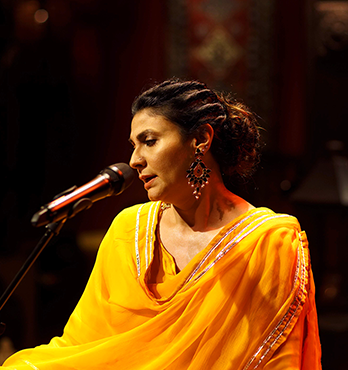Balma

by Ayesha binte Rashid
The canvas of Coke Studio Season 12 has been painted with the many colors and shades of romance. The Studio’s lyric sheets are covered with poetry written for lovers — declarations of how they have made homes in people’s hearts and rendered entire nights sleepless. A spectrum of emotions has found expression in this poetry, from the simple joy of newfound romance to the yearning of separation. Subtext and meaning have been interlaced into this poetry turning the theme of love into a metaphor — one that gives expression to spiritual philosophy.
In Balma, the expression of love is earnest and modest: “ Balma bina naaheen chain”. The chorus, a couplet, sums up how the singer feels: balma bina naaheen chain, birha ki maari more rowat nain — without my beloved, I have no peace; suffering in this seperation, I weep..
Two three-line antaras (stanzas) accessorize these two lines: in the first antara, the speaker describes how her eyes are soaked with tears. Her friends pose questions, she says, asking her why tears flow from her eyes, night and day. In the second stanza, the speaker goes on to bemoan how she has no peace without her beloved. Nothing in life appeals to her anymore — her heart is restless and tormented by memories of her beloved.
Balma is a thumri, described by its singer, Fariha Pervez, as a genre that is the “pop version” of Eastern classical music — it is categorized, formally, under neem-classical, or light-classical, music. Thumri traces its genes back to the desi (folk) culture of Northeast India, to what is currently Uttar Pradesh and Bihar, and its interaction with more classical, or “high” culture. Music and poetry from the desi culture of village and household life traveled into cities and mingled with margi (classical) forms of poetry and music, which were being patronized formally in courts and darbars. In this process, neem-classical genres like thumri, dadra and kajri emerged across the region.
In popular culture, the formalization of thumri under the umbrella of classical music is said to have been initiated during the nineteenth century, in the Lucknow court of Wajid Ali Shah, the Nawab of Avadh. Under his patronage, courtiers began to merge the styles of their desi songs with elements of margi (classical music). Combining the more informal structures of their melodies and scales with the technical and structured raags of classical music, these courtiers brought thumri into the Nawab’s court, elevating it to margi status. After Wajid Ali Shah’s territories were annexed in 1856, musicians from his court travelled to other parts of India, taking thumri with them — the genre quickly became popular in the other city centers in the Subcontinent.
As princely states lost their power to British rule, the arts in India found themselves under the patronage of the state, and industrialist and middle-class consumers. Performance spaces moved from mehfils and darbars to bigger concert platforms and, with the arrival of the radio, to private homes. India saw an increasing shift towards ‘purifying’ music and literature by identifying them with the spiritual narratives that ran through culture. In this changing environment, thumri found itself being threatened. A genre that speaks of love and desire, thumri was performed largely by courtesans in the intimacy of kothas and darbars — both the artform and its performers found themselves displaced in an increasingly sanitised cultural landscape.
Thumri singers began pursuing other avenues, becoming actresses in theatre and film or pursuing other genres of classical singing. Thumri survived, however, as some singers rose to prominence on radio and in film and, overtime, its simple appeal rendered it a popular neem-classical genre that continues to be sung today.
While different stylistic features may be found in thumri as one travels across the Subcontinent, its canvas remains relatively smaller than that of classical genres like khyal gaiki and qawwali. The genre makes use of a limited range of raags (scales) and light, small taals (rhythms), and its lyrical compositions are uncomplicated. Thumri lyrics are almost exclusively written for a feminine voice, articulating love, desire, and romantic sorrow. While thumri has traditionally been sung by women, composers and teachers of thumri have generally been male, so it is not the gender of the composer, speaker or singer that gives the poetry its femininity. The dynamics of the performance, and the use of musical notes and raags, is what gives thumri its feminine quality.
The defining feature of thumri is the repetition of a particularbol (phrase) that is consistently repeated throughout the song — balma bina naaheen chain. The simplicity of the lyrics and musical composition, however, masks a technical delicateness — thumri singers create subtle twists and turns, both making and exploring spaces and ambiguities in poetry and music. Thumri explores the ang (weightage) and chalan (movement) of raags, their points of fluidity, playing with their margins and boundaries, often allowing other raags to drip in, creating a colorful musical palette that can be used to subscribe a range of meanings to the repeated lyrics of a song.
Using these spaces in sur (tone and notes), thumri plays with spaces in the meanings of bol, creating multiple plains of feeling and interaction. With each repetition, there may be a slight change in ang or chalan, a slight change in sur, that will display the bol in a new light. In thumri, the interaction between the poetry and music becomes complex in this way, with words becoming a musical element. In other genres, music serves the text, but in thumri, poetry’s aesthetic value is rendered musical, rather than literary.
As Fariha Pervez takes the stage on Coke Studio Season 12 and calls out balma bina naaheen chain , one may wonder if she is calling out to her balma or telling the audience of their restlessness? When she sings out, “ Poochhen mose sakhiyan, bheegi mori akhiyan ,” is she telling the audience of how her friends question her, or is one hearing a conversation with her balma ? Sung in the melodies of Fariha’s voice, the poetry, simple and concise, flows like music. In a musical space that gives centerstage to her voice, one is offered a chance to pause and find their own emotions unfolding in the expression of a restless heart.
